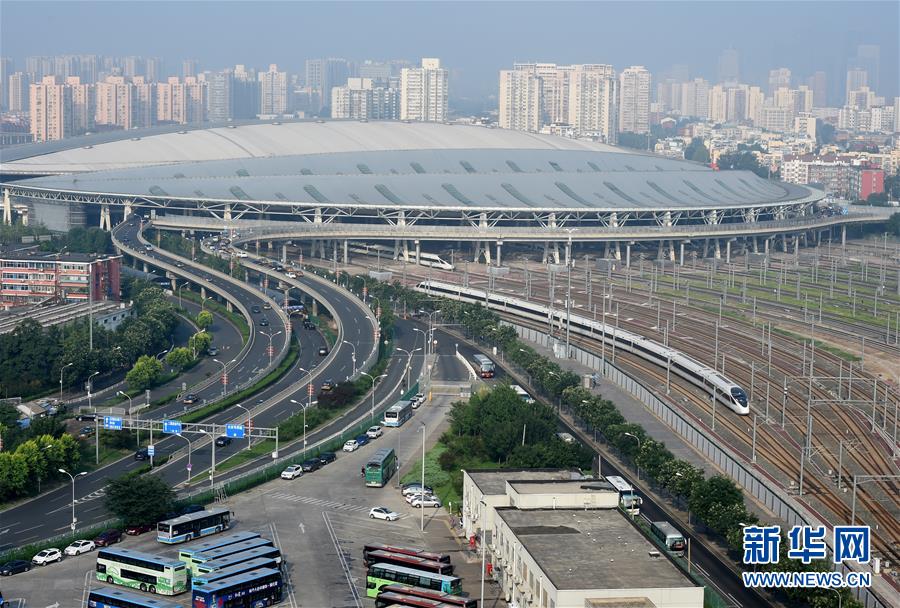Gaining momentum: China's high-speed railway marks 10-year milestone
 0 Comment(s)
0 Comment(s) Print
Print E-mail China.org.cn, August 7, 2018
E-mail China.org.cn, August 7, 2018
A Beijing-Tianjin inter-city train leaves the Beijing South Railway Station on Aug. 1, 2018. [Photo/Xinhua]
On Aug. 1, 2008, the Beijing-Tianjin Inter-city Railway was launched at a top speed of 350 kilometers per hour, marking the beginning of China's high-speed railway era.
In the past decade, China saw the formation of an enormous high-speed railway network that stretches from the Bohai Sea in the east to the Gobi Desert in the west, from the central plains to the mountains in the southwest, and from the snowfields in the north to the riverside towns in the south. Now, the total operating mileage of China's high-speed railway network is more than 25,000 kilometers, accounting for two thirds of the world's total.
Extending in all directions, China's high-speed railway has vastly improved the travel speed for its citizens and created a new driver for the country's economic development and innovation.
10 years of fast development
Tianjin Station, which is reconstructed from the former Laolongtou (lit. ancient dragon head) Station built during Emperor Guangxu's reign (1875-1908) in the Qing Dynasty, has witnessed the tremendous development of China's railway from the beginning. From the Great Wall double-deck tourist train in the 1990s, to the Shenzhou double-deck diesel multiple units (DMUs) in 2000, and then to the Hexie inter-city rail, commuting time from Beijing to Tianjin has shortened drastically to around half an hour.
"As the pioneer of China's high-speed railway, the Beijing-Tianjin Inter-city Railway is more than just the first ever high-speed railway in China, it also contributed many innovation breakthroughs and set many service standards," says Zhou Bin, deputy chief of the Tianjin section of Beijing Railway Bureau.
As China's first independently built high-speed railway that runs at the speed of 350 kilometers per hour, the railway has made a spate of technology breakthroughs including civil engineering, joint debugging and testing, system integration, establishment of the operations management system, R&D of wide carriages, technical standard system, as well as service standard for high-speed railways, according to Zhou.
In the past 10 years, the number of trains shuttling between Beijing and Tianjin has increased from 47 pairs to 108.5 pairs. Passengers who were mostly tourists and family visitors in the beginning have expanded to include business people, commuters and students, totaling 250 million. The railway is believed to have helped in the coordinated development of Beijing, Tianjin, and Hebei province.
As one of the stations between Beijing and Tianjin, Wuqing Station in Tianjin has served more than 12 million passengers in the past 10 years. Thanks to the Beijing-Tianjin Inter-city Railway, Wuqing district now receives more than 16 million tourists annually, many of them are from Beijing, according to an official at the district's tourism center.
'China Speed'
"China Speed" is changing people's lives. Wang Ye, who works at a tech company located in Wuqing district, rides the C2205 to work every morning. In less than half an hour, Wang and more than 20 of her colleagues travel from Beijing South Railway Station to Wuqing Station. Driven by the high-speed rail, Wuqing district has attracted more than 8,000 companies in the past five and a half years, including a number of leading companies and institutions such as the Railway Research Institute of China Academy of Railway Science.
The Tianjin Binhai – Zhongguancun Science & Tech Park, located on the extension line of the Beijing-Tianjin Inter-city Railway, has also attracted many investors. Since its establishment at the end of 2016, more than 500 enterprises have been registered there, many of which are from Beijing's Zhongguancun.
The Beijing-Tianjin Inter-city Railway is an epitome of the fast development of China's high-speed railway. By the end of 2017, the total number of passengers who traveled on China's high-speed trains had reached 7 billion. By 2020, China's total operation mileage of high-speed railway is on track to reach 30,000 kilometers, covering 80 percent of its major cities.
Continuing to innovate
Since 2004, China has developed various key technologies in train control system, such as the CTCS-2 system and the CTCS-3 system. Currently, China's high-speed railways are working on smart technology and services. In 2019, the smart-type Fuxing bullet train will be put into use for the first time in the Beijing-Zhangjiakou High-speed Railway. And by 2020, the Beijing-Xiongan Inter-city Railway will be finished.
China's high-speed railway is also going global, such as the Ankara-Istanbul High-speed Railway, the Jakarta-Bandung High-speed Railway, and the Moscow-Kazan High-speed Railway. In just a few years, it has rolled out overseas with leading technology, excellent quality and superior service. By continuing to innovate, China's high-speed railway is bringing concrete benefits to the world.






